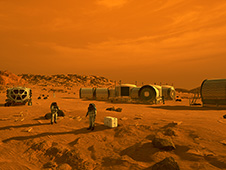
The United Nations expects the world’s population to reach 9 billion by the year 2050. And, of course, feeding this population will be a daunting challenge. We all know about the advent of genetic manipulation of plants to yield hardier crops, but many stakeholders have both explored and invested in other farming alternatives, which range from farming underwater to farming in the desert. Let’s take a look at some of these options:
Farming in the Desert
British designer, Charlie Paton, traveled frequently to Morocco and was struck with the idea of converting nearby sea water into fresh water to irrigate plants. He set about designing just such a method, and came up with Seawater Greenhouse. The greenhouse is inexpensive to produce, about $5 a square foot, and works by collecting water from the sea, allowing it to trickle down to honeycomb-shaped lattices where it evaporates, cooling and humidifying the air inside. The air warms up as it travels across the greenhouse and is fed into a second evaporator, which supersaturates it. From there, the air quickly moves to a condenser, which pulls out freshwater and moves it to an underground storage tank for plant irrigation.
Interconnected Energy and Food Production System
Alltech envisions a farm that uses an interconnected system of algae production, aquaculture, a biorefinery, solid state fermentation, and a cogeneration plant. In this system, fibrous materials such as corn cobs, rice bran, and wheat bran would be recycled into nutrient-rich feed at the solid state fermentation plant, which in turn, produces enzyme-activated fiber, a key ingredient for the biorefinery’s ethanol production.
Ethanol production creates carbon dioxide, which is recycled in the algae field, and is converted to oxygen. The aquaculture center sends nitrogen from fish waste to the algae field where it enhances algae growth. In return, the algae provides feed for cattle. The fish waste also provides fertilizer for the crops.
At the cogeneration plant, the biorefinery’s yeast byproducts are used to produce bio-gas that generates heat and electricity, which is given to the biorefinery and the SSF plant. The cogeneration plan also recycles water for irrigation. Little to no waste is envisioned within this self-sustaining system.
Large-scale Urban Farming
Some big news that recently hit concerned Whole Foods contracting with Gotham Greens to develop a 60,000 square-foot greenhouse on the top of its store under construction in the Gowanus Canal district of Brooklyn. Greens and herbs grown in the greenhouse will be sold in the store below and at other Whole Foods New York locations. This distribution system will cut down on transportation costs and greenhouse gas emissions, and the production cycle will include sustainable technologies such as solar-generated power and an irrigation system that uses 20 times less water than traditional farming.
The New York City Housing Authority (NYCHA) also recently launched the Red Hook Urban Farm, a 1-acre urban agriculture installation and the first-ever large-scale community farm on NYCHA property. The farm will provide fresh produce for the community as well as a center for education, job training, and community engagement for residents. Within this self-sustaining system, produce will be sold at farmers’ markets or donated to families in need, and revenue from sales will fund members of the Green City Force Clean Energy Corps, which combines national service and workforce development to lower energy consumption and provide urban youth with training and leadership opportunities related to greening the economy.
In another project, in Bedford Park, Illinois, the organization called Farmed Here renovated an abandoned warehouse with the intent of converting the building into a vertical farm with 150,000 square feet of growing space. Farmed Here will hire newly released non-violent offenders and train them for work inside their facility. The farm uses a soil-free, aquaponic process to grow organic greens in a mineral-rich water solution derived from tanks of tilapia. The facility plans to provide 1 million pounds of chemical-, herbicide- and pesticide-free greens such as basil and arugula to the Chicago area once full production is reached.

Permaculture
The word, permaculture, was developed by Australian authors and farmers Bill Mollison and David Holmgren, and is a combination of the words, permanent and agriculture. Permaculture is a system of farming that works with, rather than against, nature. Those using permaculture design farms in harmony with nature to provide food and energy in a sustainable manner. For example, instead of having clumps of trees surrounded by open fields, a permaculture farm may include a collection of small clearings within a woodland, each serving a purpose. Each plant also has a purpose, a specific job that contributes to the farm. One plant may produce nitrogen; another could collect potash, salt that contains water-soluble potassium that is used in fertilizers; another plant deters pests; and another with deep roots pulls up nutrients and minerals from deep within the soil. Animals also serve specific purposes. Birds produce phosphate and eat phosphate-rich seeds and insects, and recycle the nutrient through their dung and transfer it to the soil. Ducks eat slugs and other insects to keep down the pests. Farm animals eat willow, lime, and ash branches, in addition to grass, and produce all-natural fertilizer. All of these processes contribute to the cycle of sustainability within permaculture.
Of course, these are just a few of the potential solutions to the food-supply challenges of the near future. And with the future seemingly getting closer every day, it will be interesting to see which of these methods will prove the most efficient.










